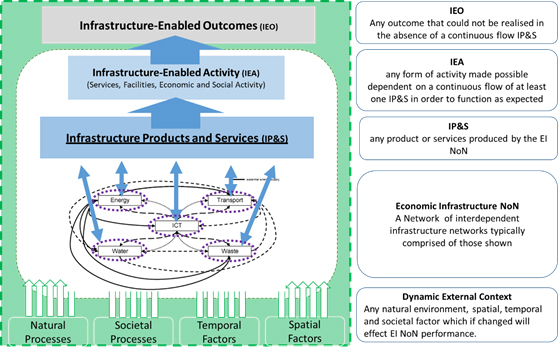Economic infrastructure produces goods and services that catalyse other economic and societal activity, create multiplier effects, and support societal outcomes that simply would not occur in their absence (Figure 1). All aspects of modern society, including quality of life, social cohesion, economic prosperity and productivity are now enabled either directly or indirectly by economic infrastructure.
The UK’s economic infrastructure is a system comprising an interdependent network of economic infrastructure networks (NoN), and associated governance and regulatory frameworks.


HM Treasury expects UK economic infrastructure to enable three outcomes:
- Foster long-term and sustainable economic growth across all regions of the UK.
- Improve the UK’s international competitiveness [and productivity].
- Improve the quality of life for those living in the UK.
How does a lack of resilience affect our economic infrastructure?
Critically, if we do not make the resilient performance of our economic infrastructure system an explicit priority in all governance, regulatory and decision-making processes, we risk disruption that is more frequent, and of a longer duration, greater intensity and larger scale. This disruption would jeopardise the realisation of all other strategic outcomes enabled by economic infrastructure.
What does global warming mean for our economic infrastructure?
In this context, the IPCC Special Report on Global Warming of 1.5°C, is of direct significance. The report when published in full will state with high confidence that:
- If Global Warming continues at the current rate, global temperatures will hit 1.5°C higher than pre-industrial levels (1850-1900) between 2030 and 2052;
- To limit global warming to 1.5°C, net zero CO2 [eq] emissions must be achieved by 2030;
- Failure to do so will lead to Global Warming in the range 1.5 – 4°C.
What action must we take to mitigate this?
The findings of the IPCC reaffirm the critical need for immediate action to address two society-wide missions:
Mission A: Limit Global Warming to 1.5 °C – Achieve net zero CO2 [eq] Emissions by 2050 at the latest
Mission B: Societal Resilience to 1.5 °C – Take immediate action now to ensure our quality of life is resilient to the impacts of global warming of at least 1.5° C by 2030
Both missions address shared challenges that are neither caused, nor resolvable, by a single party acting in isolation. Furthermore, no magic bullet is available, or ever will be, to deliver these missions. Both missions will require a collaborative portfolio of responses, comprised of multiple action types, and implemented by a diverse network of communities of interest.
What happens if we do nothing?
Inaction on Mission A is simply not an option. If we fail on Mission A then we fail to limit global temperature change to 1.5 °C. This is significant, because the required level of resilience to the impacts of global warming will become that stated in Mission C, rather than Mission B.
Mission C: Societal Resilient to 2-4°C – Take immediate action now to ensure our quality of life is resilient to the impacts of global warming in the range 2° – 4 °C by 2030
Likewise, inaction on Mission B is not an option. Global warming of at least 1.5 °C is inevitable. Therefore, ensuring Resilience to the impacts of 1.5 °C is essential. If we don’t prioritise at least this level of resilience now, we will inevitably face more frequent, longer duration, greater intensity and larger scale disruption to our quality of life as a result of global warming.
Considering our collective response
To catalyse society-wide action, we must change the conversation regarding mitigation and resilience. In the context of climate change, neither can be dismissed as an unaffordable luxury. Investment in both is now a pre-requisite for future economic success and sustaining our current quality of life. Inaction is now the unaffordable luxury.
Therefore, addressing Missions A and B is in our enlightened self-interest. Economic infrastructure, as an enabler of modern societies, has a significant role to play. Indeed, without economic infrastructure that is both Resilient to global warming of at least 1.5° C and produces net zero CO2 [eq] emissions neither Mission A nor B can be achieved at the societal level.
Christiana Figueres at the 2018 World Economic Forum called for “a quick and radical shift away from low-resilience, high-carbon infrastructure to low-carbon, high-resilience infrastructure’’.
However, economic infrastructure is a catalyst, not a magic bullet. Complementary actions across all levels of Figure 1 are also needed if Missions A and B are to be realised.
With this in mind, we collectively need to consider the following 3 sets of questions:
1. What role can the economic infrastructure system play in supporting Mission A? Specifically, how can the CO2 [eq] emissions associated with economic infrastructure and its use most effectively reduced across the whole life-cycle at the system level. Can this be done without exacerbating the resilience challenge?
2. What is the portfolio of actions needed to ensure the performance of our economic infrastructure is resilient to the impacts of global warming in the range 1.5-4o C? Can this be done without exacerbating the mitigation challenge?
3. What complementary actions can be taken at other levels of Figure 1 to support Missions A and B?
This article first appeared at resilienceshift.org.
Photo credit: NightFlighttoVenus via Flickr



